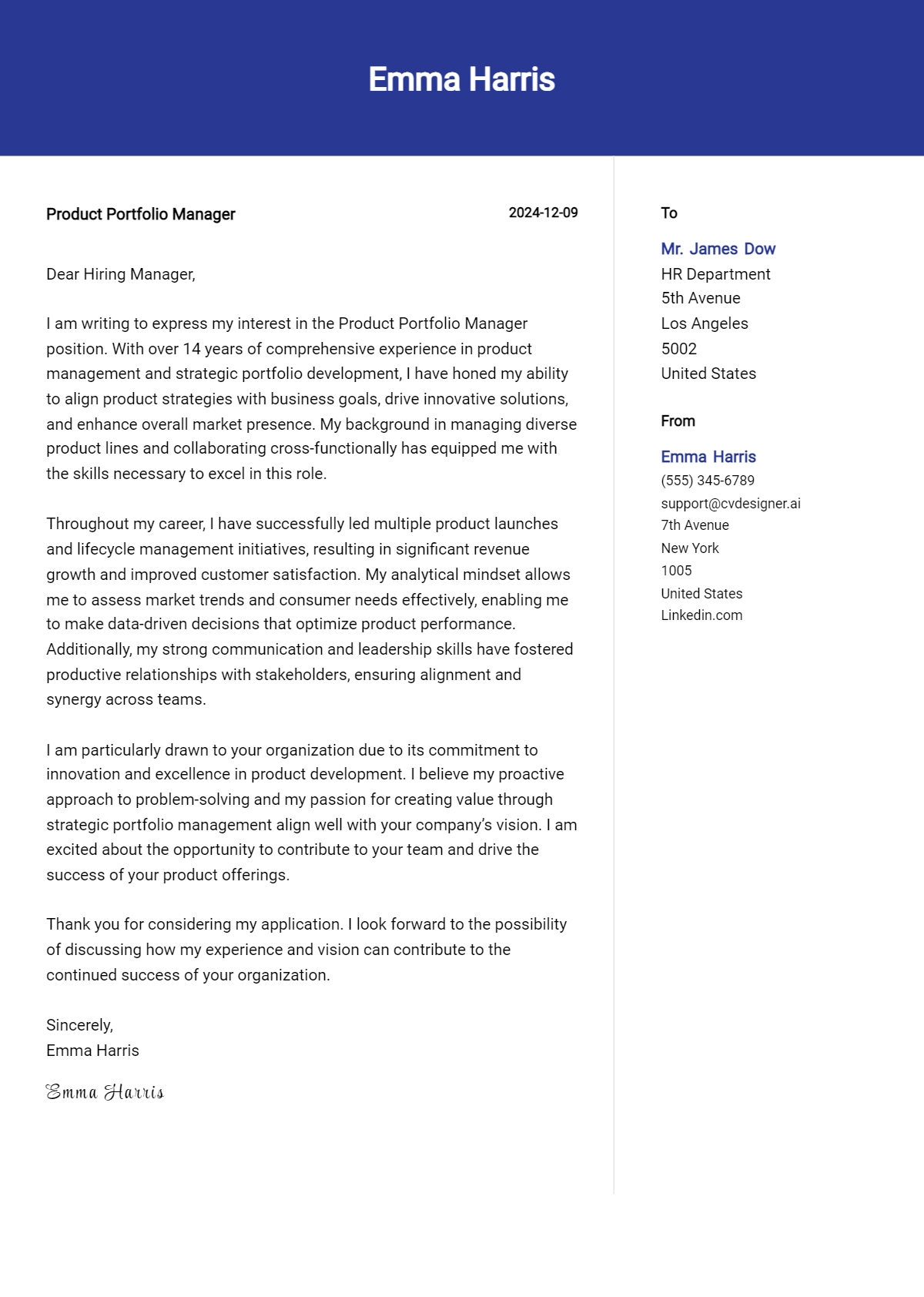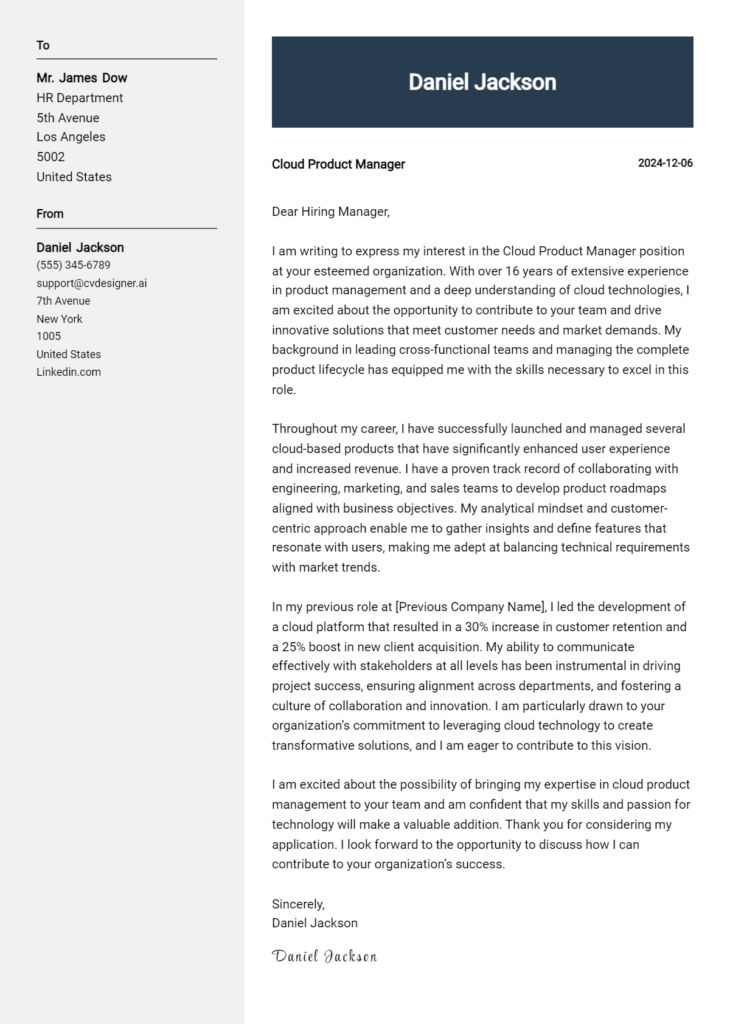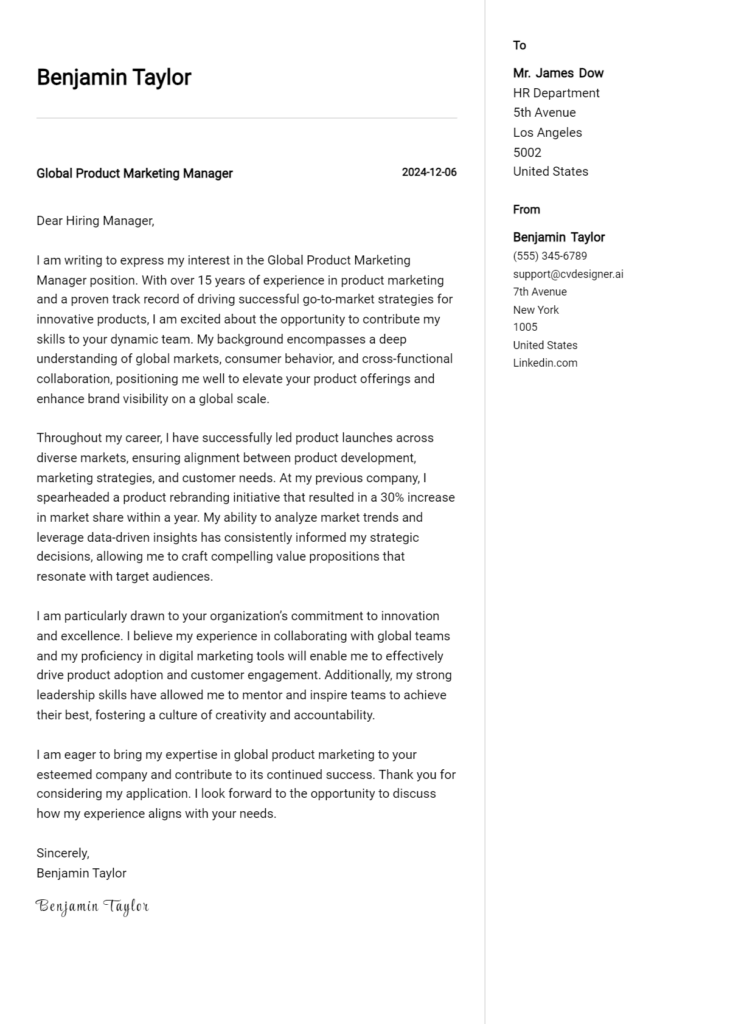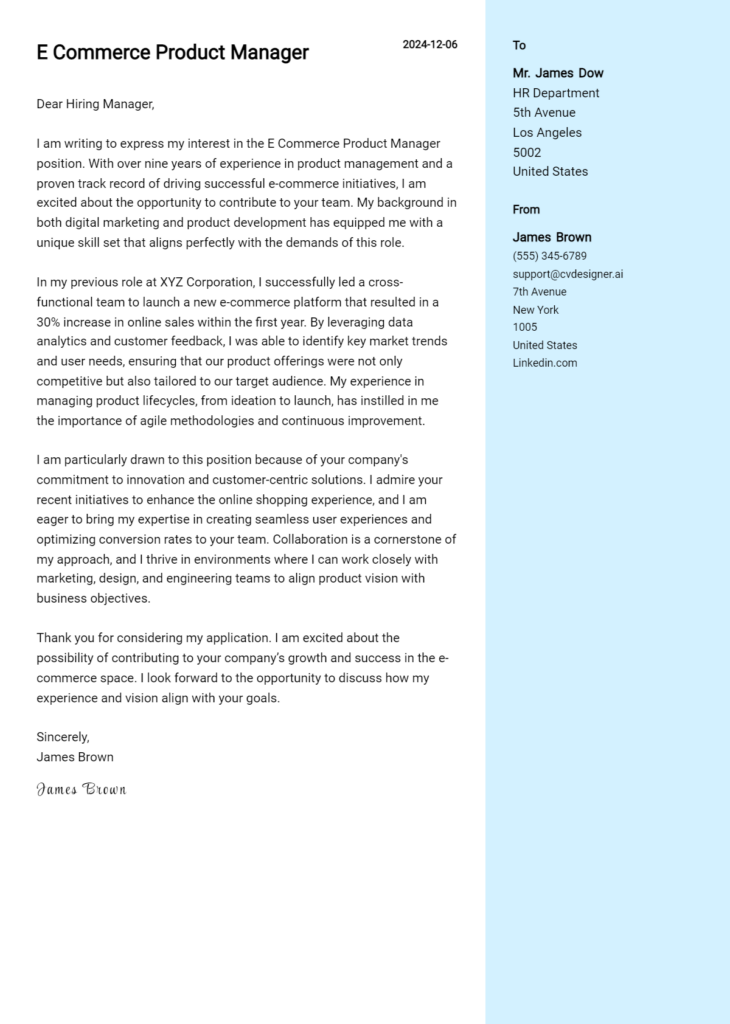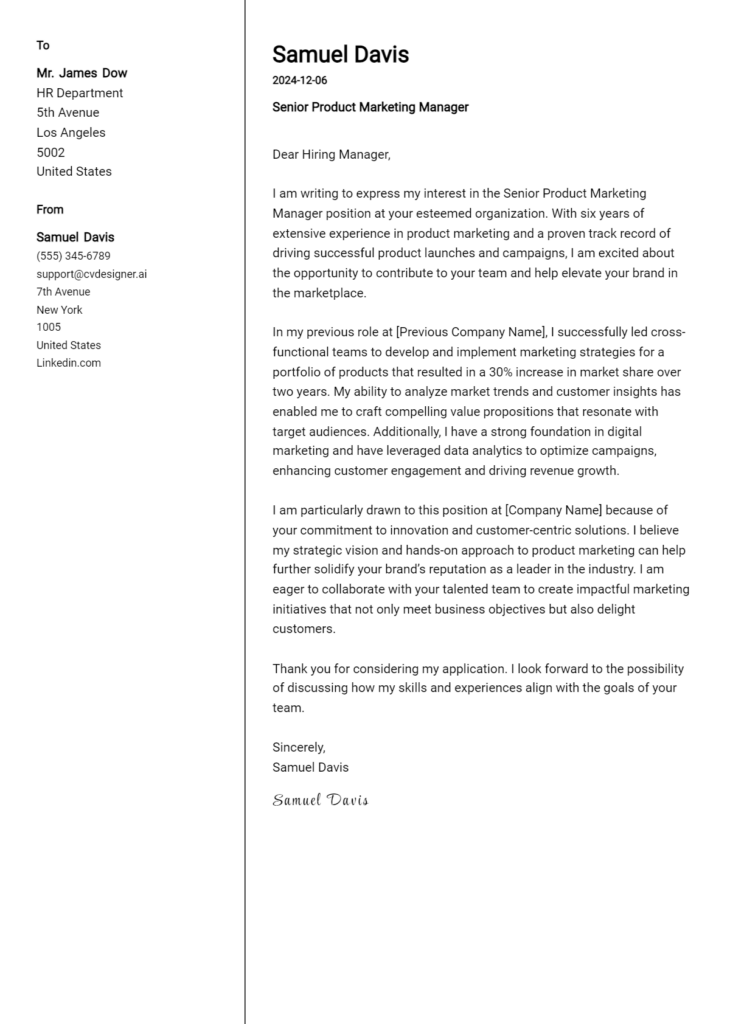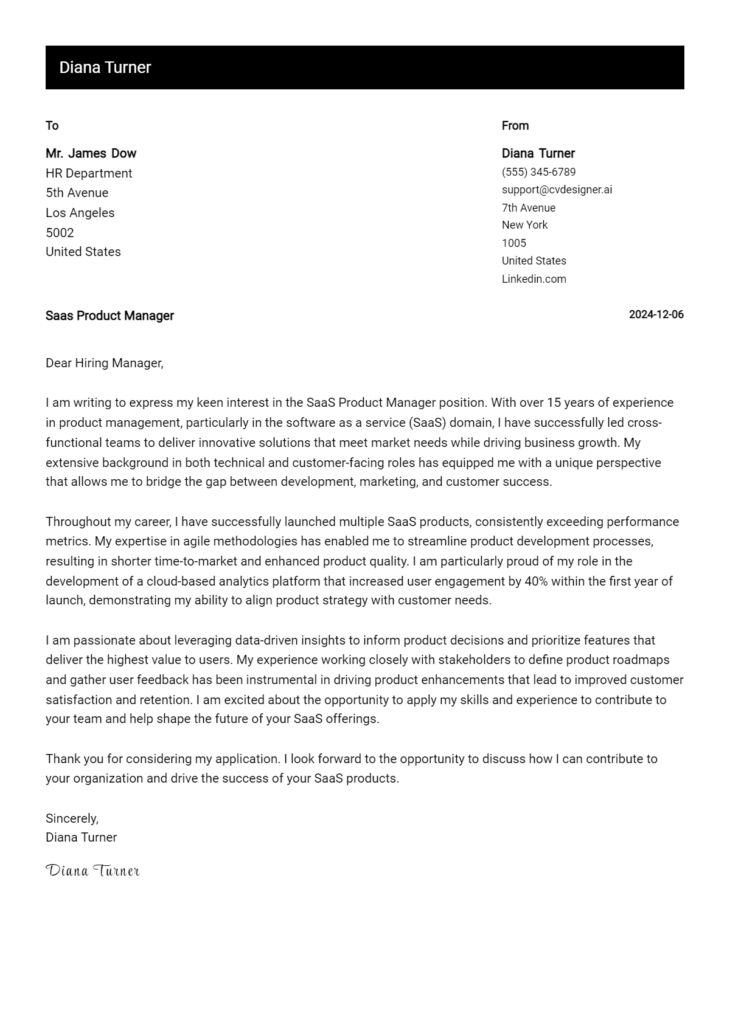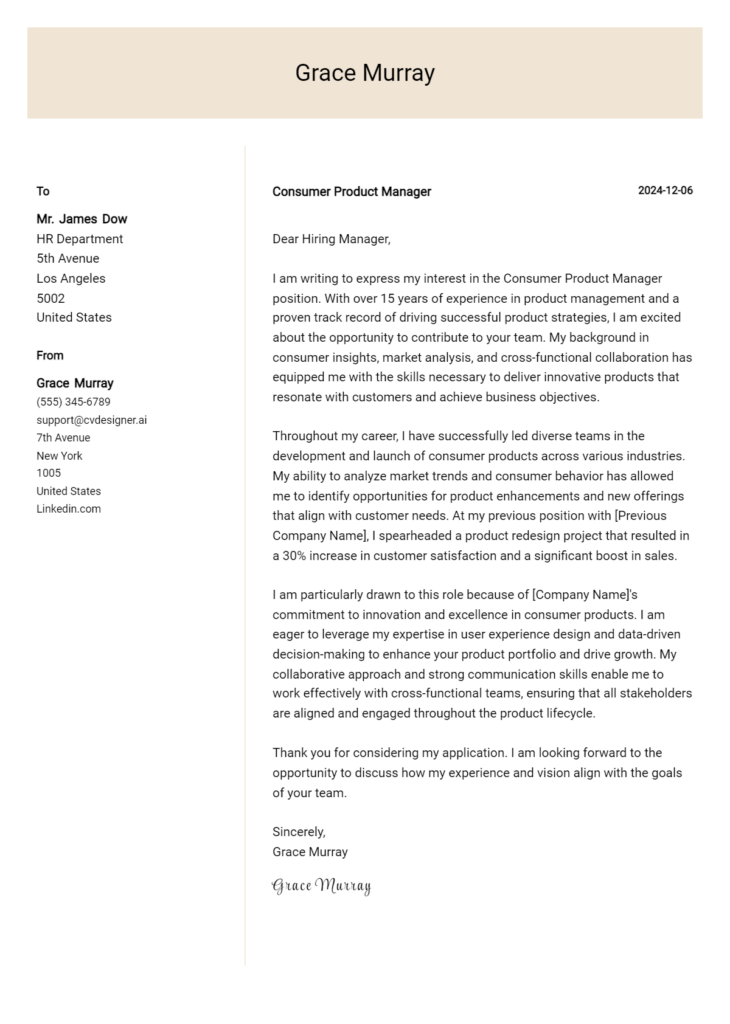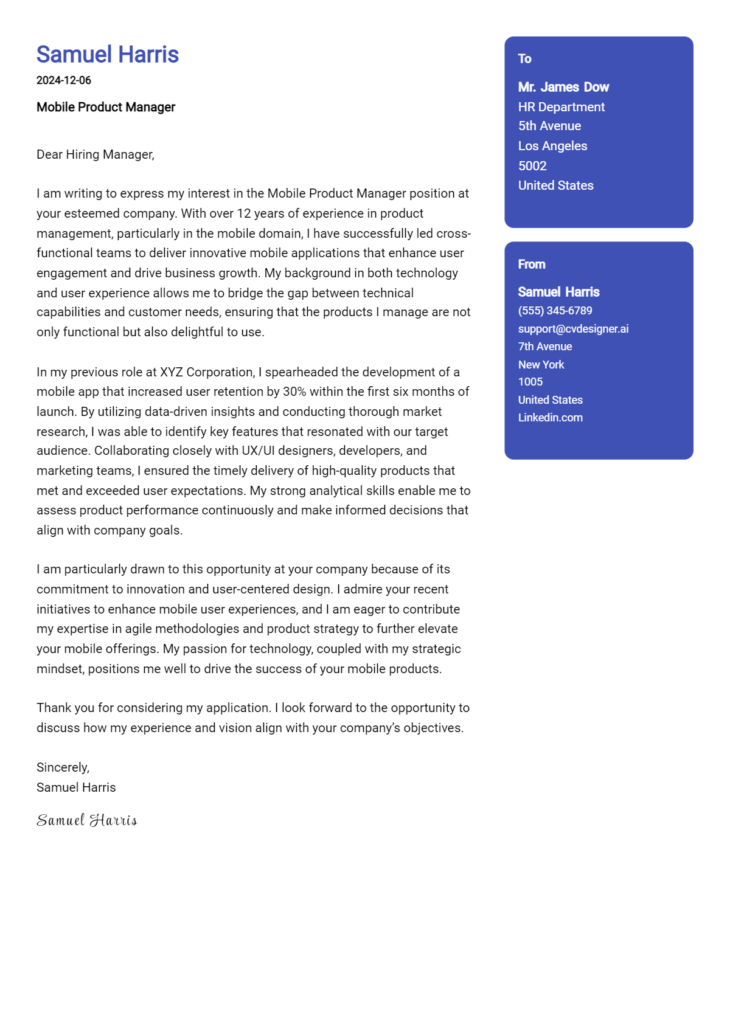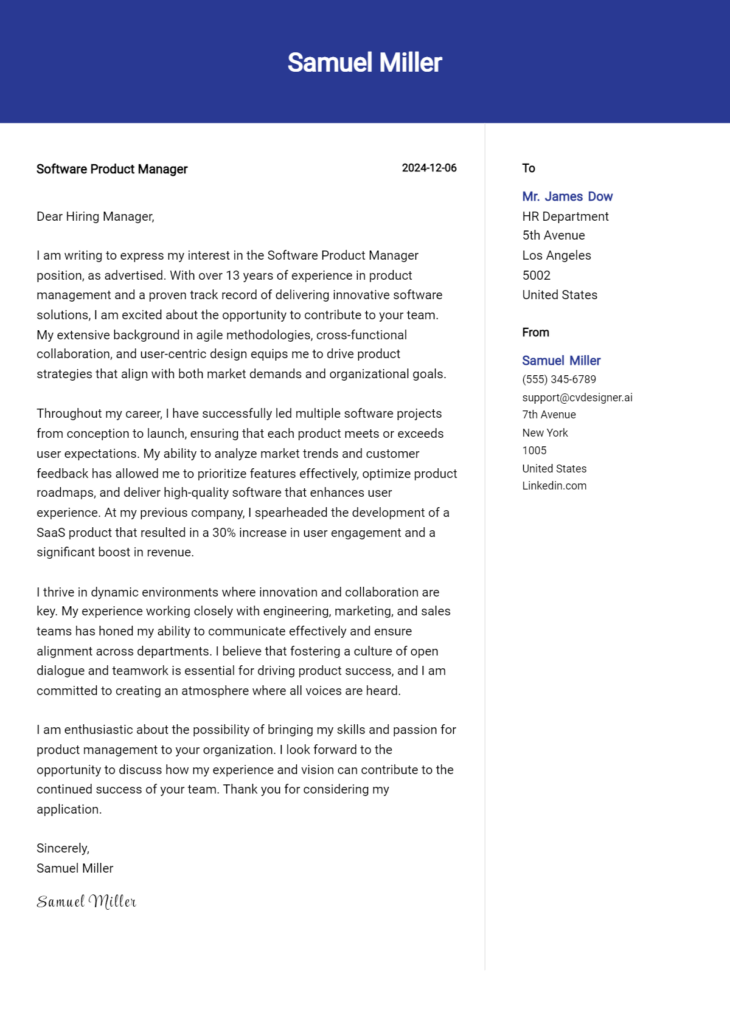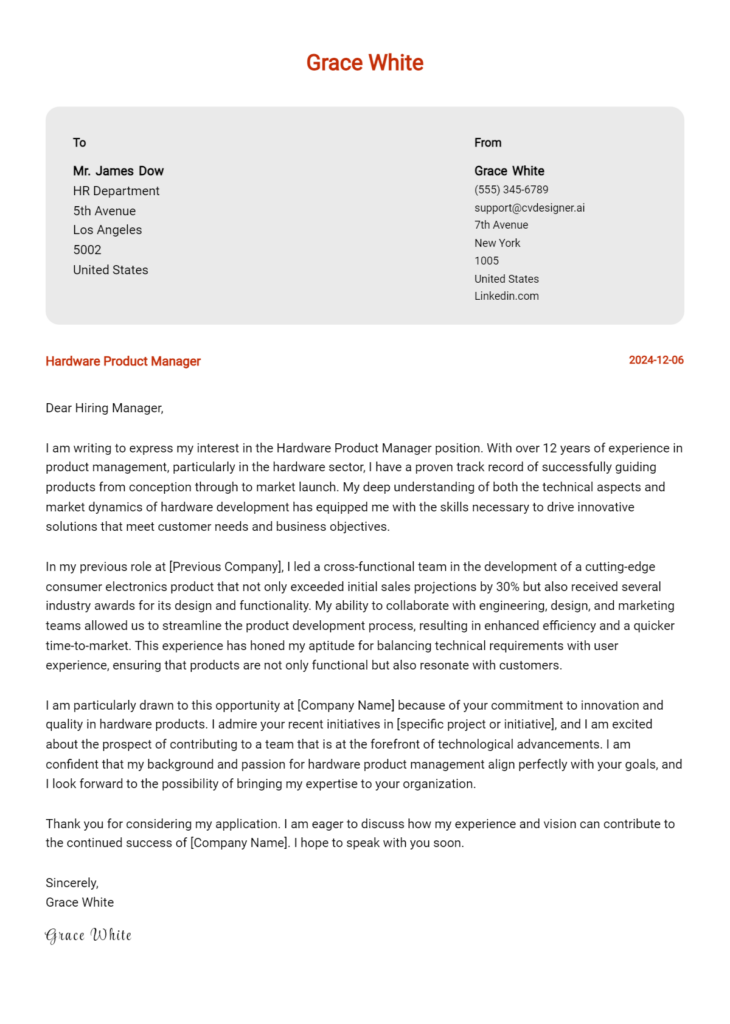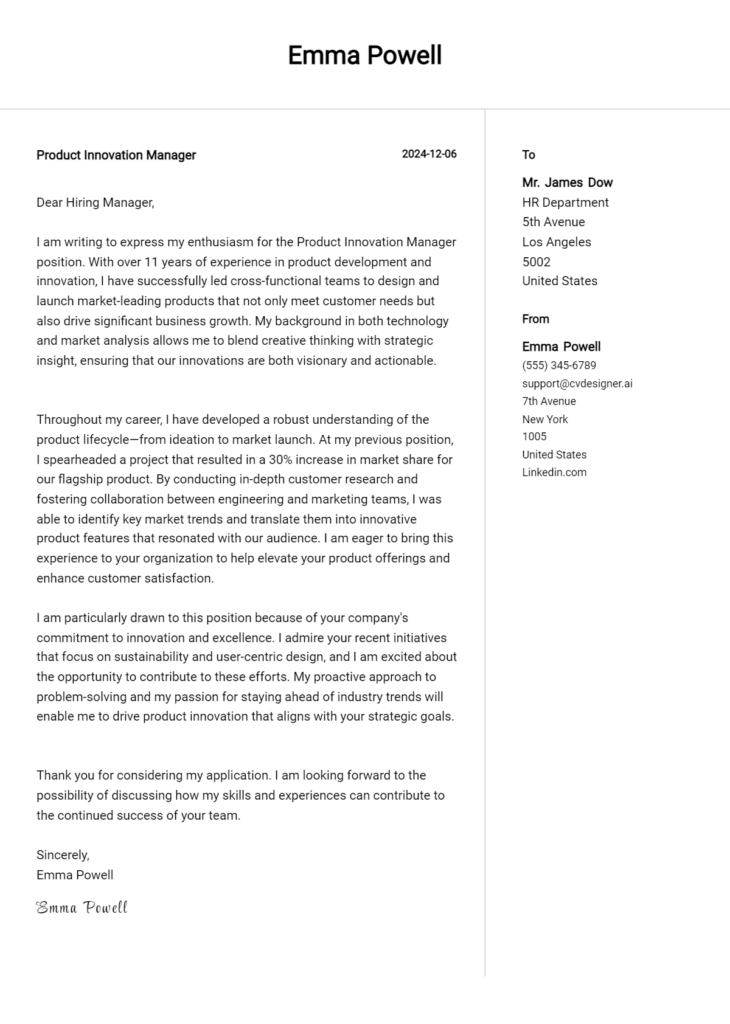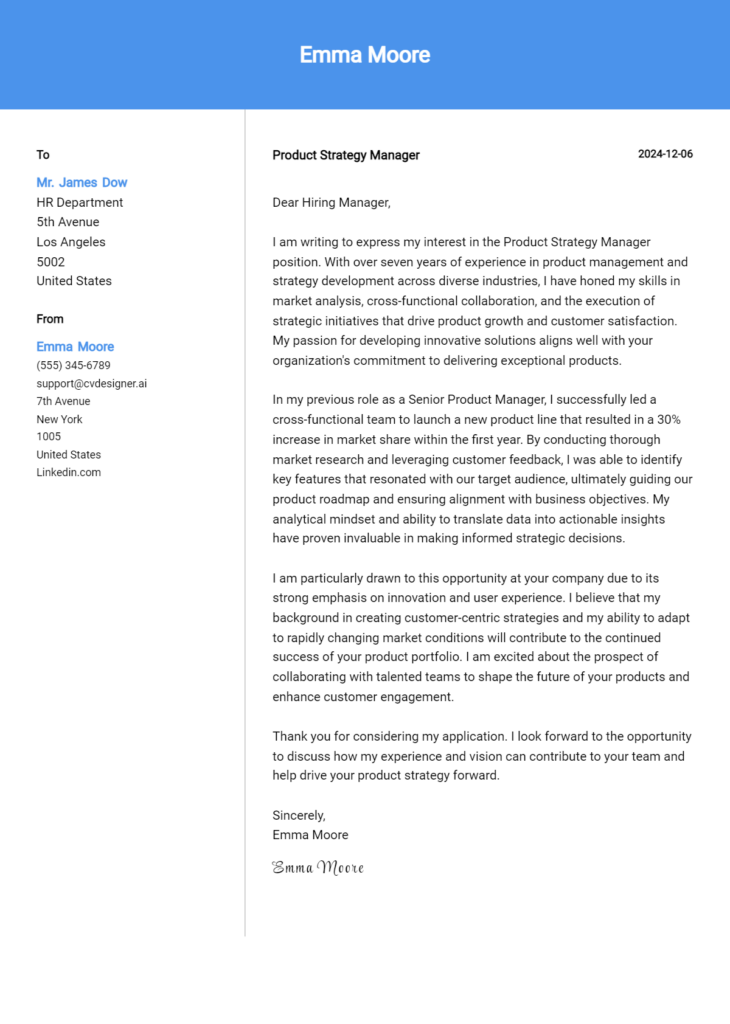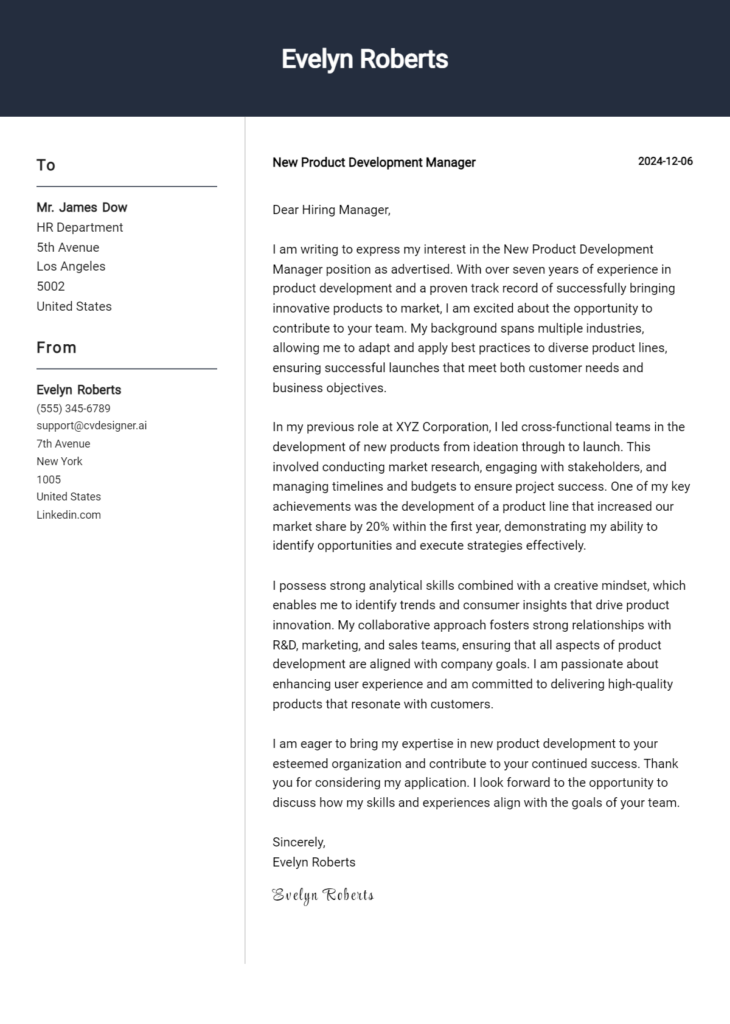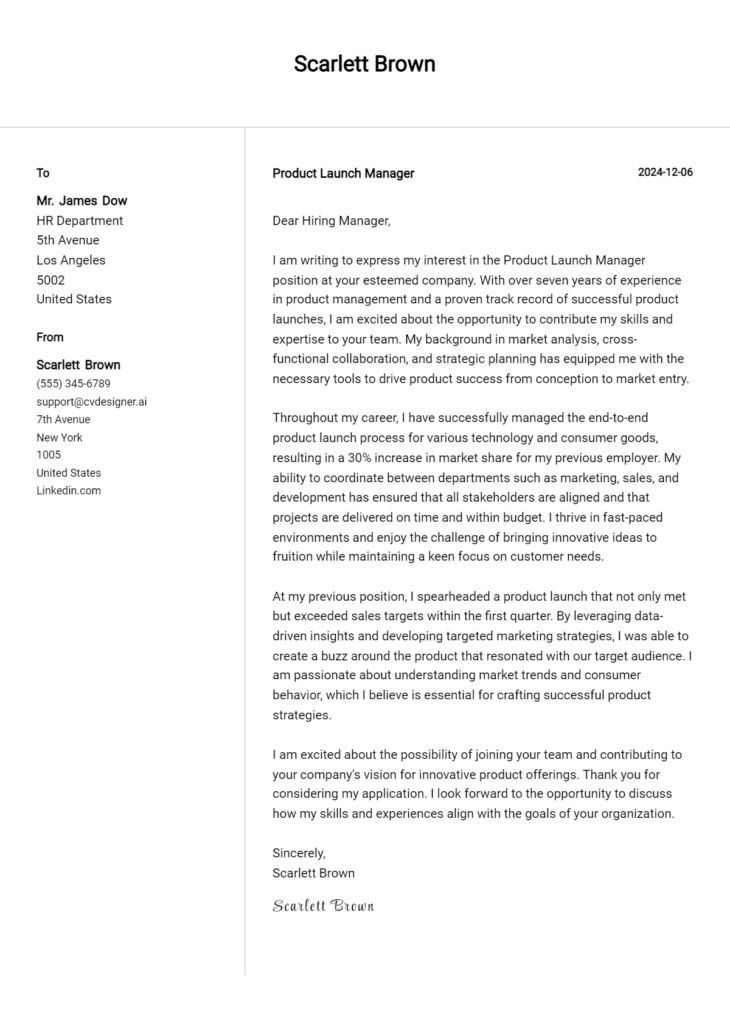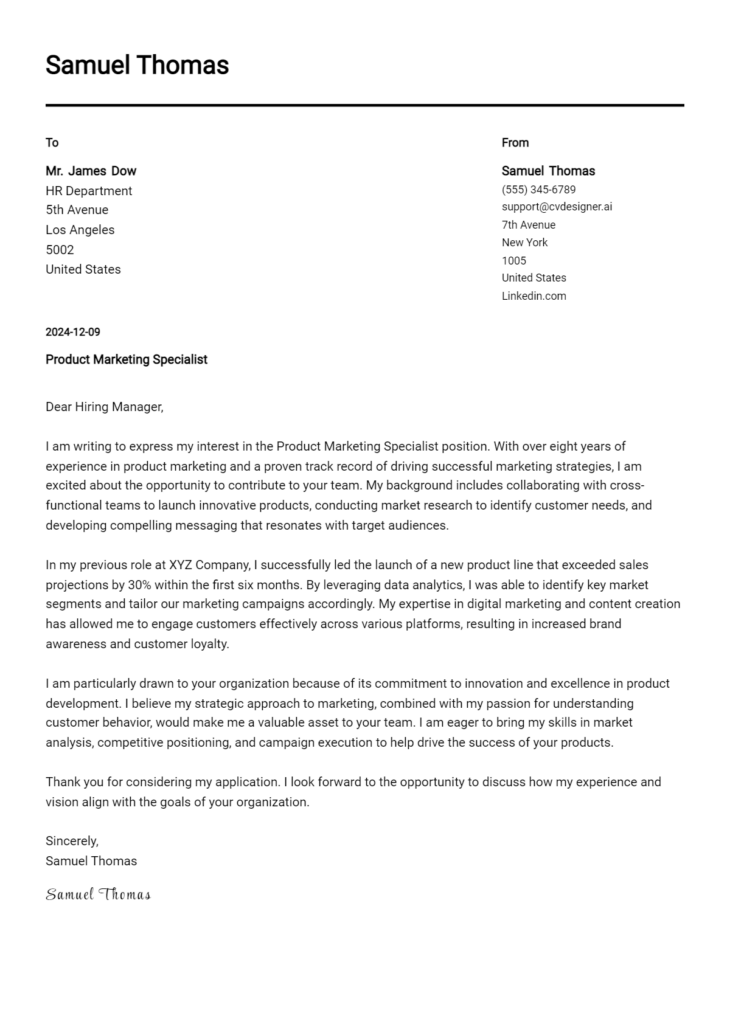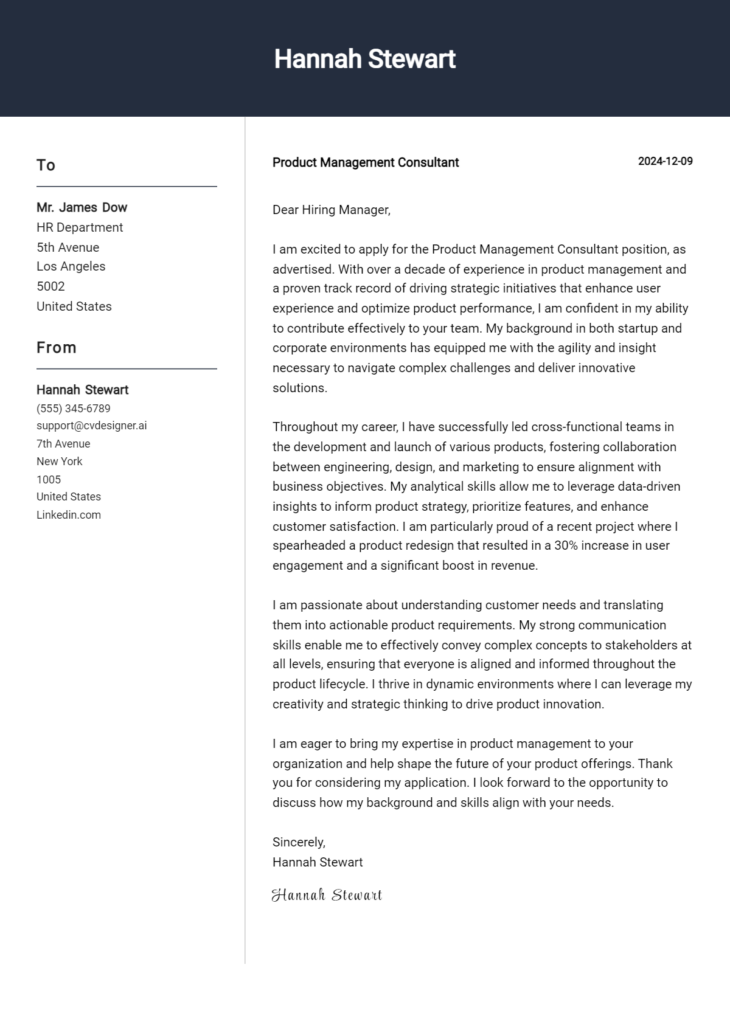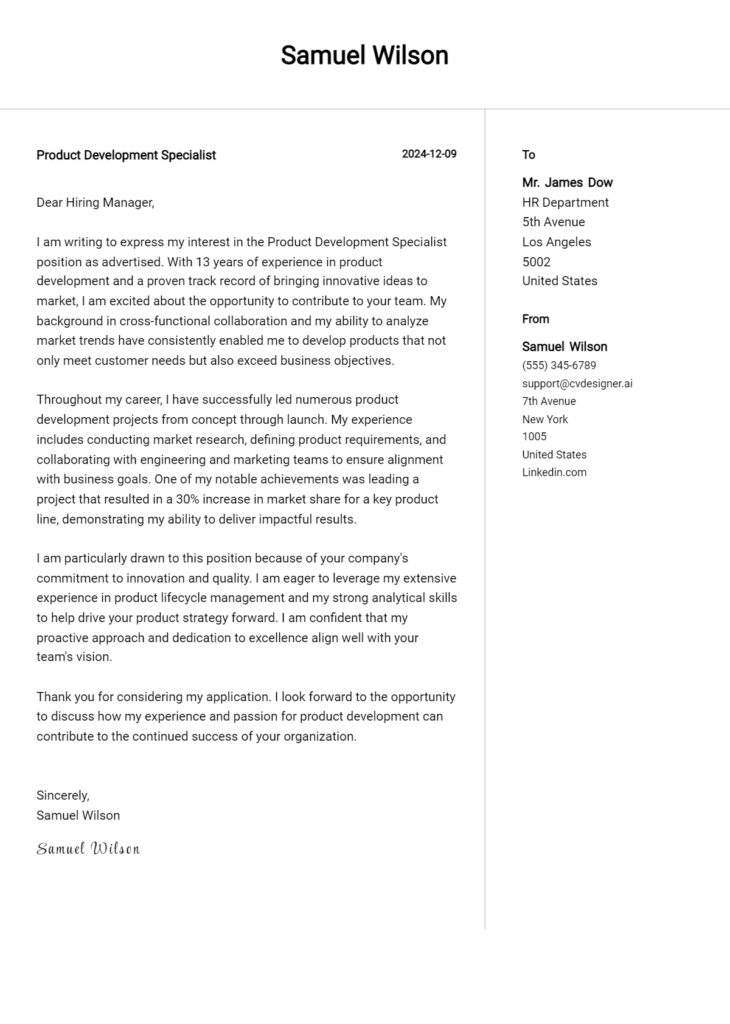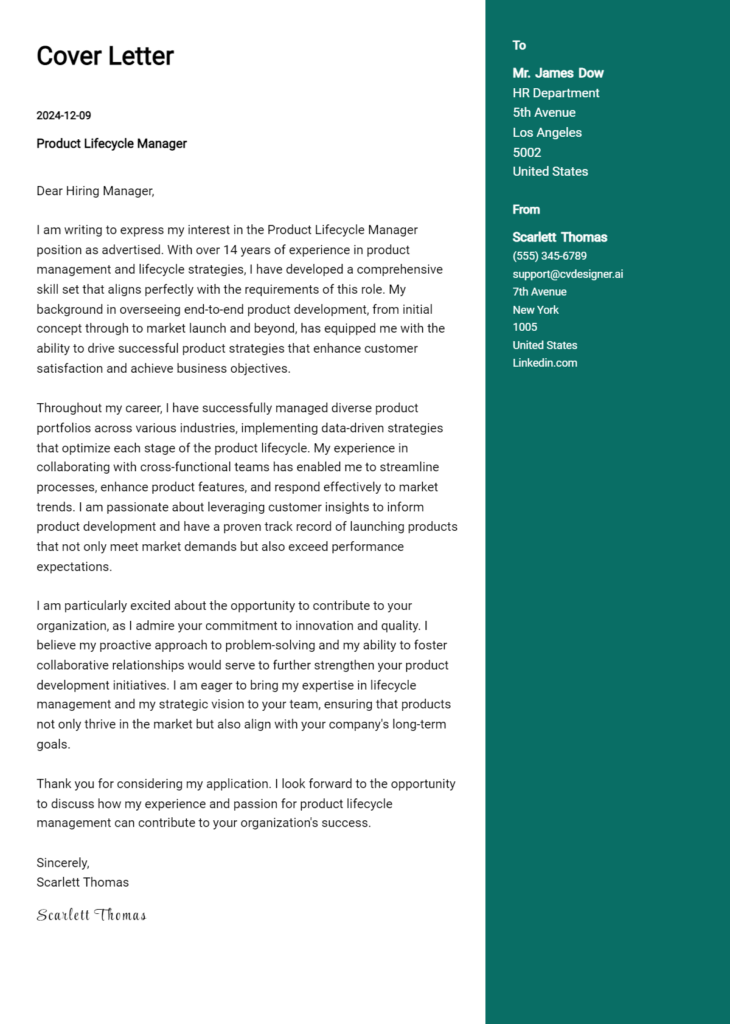Product Portfolio Manager Cover Letter Examples
Explore additional Product Portfolio Manager cover letter samples and guides and see what works for your level of experience or role.
How to Format a Product Portfolio Manager Cover Letter?
Crafting a compelling cover letter is essential for a Product Portfolio Manager, as it serves as your first impression and showcases your ability to manage and curate a diverse product lineup. A well-structured cover letter not only communicates your qualifications but also reflects your strategic thinking and organization skills—key attributes for success in this role.
In this guide, we will outline how to format your cover letter effectively, ensuring it resonates with hiring managers in the product management field.
We will focus on the essential components of a professional cover letter, including:
- Cover Letter Header
- Cover Letter Greeting
- Cover Letter Introduction
- Cover Letter Body
- Cover Letter Closing
Each section is crucial for presenting your expertise and professionalism. Let’s delve into each part and learn how to craft a standout cover letter that highlights your capabilities as a Product Portfolio Manager.
The Importance of the Cover Letter Greeting
The greeting of a cover letter is a critical component that sets the tone for the entire document. A well-crafted greeting not only demonstrates professionalism but also shows a level of personalization that can resonate with the hiring manager. By addressing the recipient directly, you create a connection that encourages them to engage with the rest of your letter. Avoiding generic greetings is essential; they can give the impression of a lack of effort or interest in the specific role. Take the time to research the hiring manager's name or the appropriate title, as this small detail can significantly enhance the impact of your introduction.
When crafting your greeting, remember that strong greetings reflect your enthusiasm and respect for the position, while weak greetings can undermine your efforts right from the start. Here are examples of both:
Strong Greeting Example
Dear [Hiring Manager's Name],
Weak Greeting Example
To Whom It May Concern,
The Importance of a Strong Cover Letter Introduction for a Product Portfolio Manager
A well-crafted cover letter introduction is crucial for a Product Portfolio Manager as it sets the tone for the entire application. The introduction should immediately capture the hiring manager's attention, expressing genuine interest in the role and the company. It’s an opportunity to briefly showcase key skills or notable achievements that align with the organization's needs. A compelling introduction not only piques interest but also encourages the reader to delve deeper into the candidate’s qualifications. Below are examples of strong and weak cover letter introductions to illustrate the difference.
Strong Example
Dear [Hiring Manager's Name], I am excited to apply for the Product Portfolio Manager position at [Company Name], where my extensive experience in product strategy and portfolio management can contribute to driving innovative solutions. With over eight years of experience leading cross-functional teams and successfully launching over 20 products that generated a 30% increase in revenue, I am eager to bring my strategic vision and analytical skills to your esteemed organization.
Weak Example
To Whom It May Concern, I am writing to apply for the Product Portfolio Manager job. I have some experience in product management and think I could do well in this role. I hope to learn more about the position and what it entails.
Purpose of the Cover Letter Body for a Product Portfolio Manager
The cover letter body for a Product Portfolio Manager serves as a critical platform for candidates to articulate their unique qualifications and experiences that align with the company's needs. It provides an opportunity to highlight specific projects and accomplishments that demonstrate their ability to manage and grow a diverse portfolio of products effectively. By showcasing relevant skills, such as strategic planning, market analysis, and cross-functional collaboration, the candidate can clearly convey their value to the organization. A strong cover letter body not only reflects the candidate's expertise but also illustrates their understanding of the company's goals and how they can contribute to achieving them.
Strong Example
Dear [Hiring Manager's Name], I am excited to apply for the Product Portfolio Manager position at [Company Name]. In my previous role at [Previous Company], I successfully led a cross-functional team to launch a new product line that increased market share by 15% within the first year. By conducting comprehensive market research and leveraging customer insights, I developed a strategic roadmap that aligned with our corporate goals. Additionally, my experience in analyzing portfolio performance metrics allowed me to identify underperforming products and implement optimization strategies that resulted in a 20% increase in overall portfolio profitability. I am eager to bring my expertise in product lifecycle management and data-driven decision-making to [Company Name] to drive growth and innovation.
Weak Example
Dear [Hiring Manager's Name], I am writing to apply for the Product Portfolio Manager position at [Company Name]. I have worked in product management for several years and have some experience in launching products. I think I would be a good fit because I enjoy working with teams. In my last job, I was involved in a project that aimed to improve sales, but I don't have specific figures to share. I believe my background in product management will help me succeed in this role at [Company Name].
Importance of the Cover Letter Closing for a Product Portfolio Manager
The closing paragraph of a cover letter is a crucial component, especially for a Product Portfolio Manager. It serves to summarize your qualifications, reiterate your interest in the role, and encourage the hiring manager to take the next steps, such as reviewing your resume or scheduling an interview. A well-crafted closing can leave a lasting impression and reinforce your enthusiasm for the position, while a poorly written one can diminish the impact of the entire letter.
Strong Example
In conclusion, my extensive experience in product strategy and portfolio management, combined with my passion for driving innovation, make me an ideal candidate for the Product Portfolio Manager position. I am eager to bring my skills to your team and contribute to the continued success of your products. I welcome the opportunity to discuss my application further and look forward to the possibility of scheduling an interview. Thank you for considering my application; I look forward to hearing from you soon.
Weak Example
Thanks for reading my cover letter. I hope you review my resume and think about giving me a chance. I really want the job and will be waiting for your call.
Crafting an effective cover letter for a Product Portfolio Manager position is crucial to stand out in a competitive job market. This role demands not only a solid understanding of product management but also a blend of technical skills, problem-solving abilities, and a strong grasp of the Software Development Life Cycle (SDLC). Additionally, showcasing teamwork and a passion for continuous learning can significantly enhance your candidacy. Here are five detailed tips to help you create a compelling cover letter that highlights these essential attributes.
Tips for Writing an Effective Cover Letter for Product Portfolio Manager
Showcase Your Technical Skills
Clearly outline your technical competencies relevant to product management, such as experience with data analysis tools, project management software, or product lifecycle management systems. Use specific examples to illustrate how these skills have contributed to successful projects in your previous roles. This specificity can help demonstrate your preparedness for the technical demands of the position.Emphasize Problem-Solving Abilities
Product Portfolio Managers often face complex challenges that require innovative solutions. Share a particular instance where you effectively identified a problem and implemented a successful strategy. Highlight your analytical thinking and creativity, as well as the positive outcomes that resulted from your intervention. This will not only show your capability but also your proactive approach to overcoming obstacles.Demonstrate Your Knowledge of the SDLC
Your cover letter should reflect a strong understanding of the Software Development Life Cycle. Discuss your experience in different phases of the SDLC, such as planning, development, testing, and deployment. Illustrate how your involvement in these phases has enhanced product quality and team efficiency. This knowledge reassures hiring managers that you can effectively collaborate with technical teams.Highlight Teamwork and Collaboration
The role of a Product Portfolio Manager often involves working closely with cross-functional teams, including marketing, sales, and engineering. Provide examples of how you have successfully collaborated with diverse groups to achieve common goals. Emphasizing your ability to foster teamwork and open communication will show that you value input from all stakeholders and can lead effectively.Express a Passion for Continuous Learning
The product management landscape is constantly evolving, making it essential for professionals to stay updated with industry trends and advancements. Share how you have pursued ongoing education or training, whether through formal courses, certifications, or self-directed learning. This commitment to personal growth demonstrates your dedication to excellence and adaptability in a rapidly changing environment.
By following these tips, you can create a strong cover letter that effectively communicates your qualifications for the Product Portfolio Manager role. For additional resources, consider exploring various cover letter templates or utilizing a cover letter builder to streamline your writing process.
Common Mistakes to Avoid in a Product Portfolio Manager Cover Letter
Crafting an effective cover letter is essential for standing out as a Product Portfolio Manager candidate. Avoiding common mistakes can significantly enhance your chances of making a positive impression on hiring managers. Here are some frequent pitfalls and tips to steer clear of them:
Generic Language: Using a one-size-fits-all approach can make your cover letter forgettable. Tailor your letter to the specific company and role by incorporating relevant keywords and phrases from the job description.
Lack of Specific Examples: Failing to provide concrete examples of your achievements can weaken your narrative. Highlight particular projects or products you've managed, emphasizing measurable outcomes.
Ignoring the Format: A poorly formatted cover letter can detract from your professionalism. Adhere to a clear structure, utilizing proper cover letter format to enhance readability.
Too Long or Too Short: Striking the right balance in length is vital. Aim for a concise letter of about 3-4 paragraphs that effectively conveys your qualifications without overwhelming the reader.
Neglecting Proofreading: Spelling and grammatical errors can undermine your credibility. Always proofread your cover letter and consider using tools or colleagues for an additional review to catch any mistakes.
Focusing Solely on Yourself: While it's important to showcase your achievements, also demonstrate how your skills align with the company’s goals. Show enthusiasm for the organization and how you can contribute to their success.
Not Including a Call to Action: Failing to end with a strong call to action may leave your application lacking direction. Encourage the hiring manager to reach out for further discussion, reiterating your enthusiasm for the role.
By being mindful of these common mistakes, you can refine your cover letter and increase your chances of landing an interview. For more guidance, check out these cover letter examples to inspire your writing.
Cover Letter FAQs for Product Portfolio Manager
What should I include in my cover letter for a Product Portfolio Manager position?
In your cover letter, start by introducing yourself and expressing your enthusiasm for the role. Highlight your relevant experience in product management, emphasizing your expertise in portfolio strategy, market analysis, and cross-functional collaboration. Include specific examples of successful product launches or portfolio optimization projects you've led, demonstrating your ability to drive results and align products with market needs. Mention any tools or methodologies you’re proficient in, such as Agile or Lean principles. Finally, convey your understanding of the company's goals and how your skills can contribute to its success, ensuring you tailor your message to the specific employer.
How can I showcase my achievements in my cover letter?
Showcasing your achievements requires quantifiable metrics and vivid storytelling. Instead of stating general responsibilities, focus on specific outcomes. For instance, mention how you successfully increased market share by a certain percentage or led a project that resulted in cost savings. Use action verbs to describe your contributions and the impact they had on the organization. Additionally, incorporate any awards or recognition you've received that validate your expertise in product portfolio management. This approach creates a compelling narrative, making your cover letter stand out to hiring managers.
How long should my cover letter be?
Your cover letter should ideally be one page long, consisting of three to four concise paragraphs. Aim for about 250 to 400 words total. This length allows you to present your qualifications without overwhelming the reader. Start with a strong introduction that captures attention, followed by a body that outlines your relevant experiences and achievements. Conclude with a compelling closing statement that reiterates your interest in the position and invites further discussion. Keeping it brief and focused ensures your cover letter is engaging and easy to read, increasing your chances of making a positive impression.
Should I customize my cover letter for each application?
Yes, customizing your cover letter for each application is crucial. Tailoring your cover letter demonstrates genuine interest in the specific role and company. Research the organization to understand its values, culture, and products, and reflect that knowledge in your letter. Use keywords from the job description to align your experience with the role's requirements. Mentioning specific projects or initiatives of the company can also show that you’ve done your homework. A personalized cover letter not only highlights your qualifications but also establishes a connection with the hiring manager, increasing the likelihood of your application being considered.
Build your Cover Letter in minutes
Use an AI-powered cover letter builder and have your letter done in 5 minutes. Just select your template and our software will guide you through the process.

